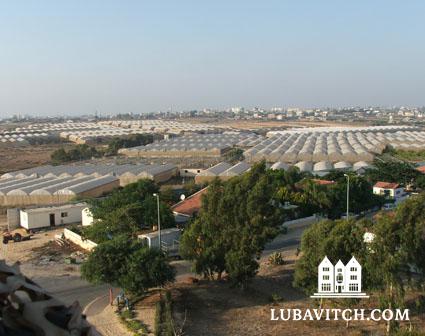(lubavitch.com) The IDF’s incursion into the Gaza strip has many in Israel taking a painfully hard look at Israel’s disengagement from the area three years ago and its failure to herald peace. A scathing report issued by State Comptroller Micha Lindenstrauss faults the government for its treatment of the evacuated Israelis, a majority of which live without bomb shelters and within Hamas rocket range in Nitsan.
As the IDF took up positions on the ruins of the former Jewish settlement of Netzarim in the Gaza Strip, the State Comptroller’s report examined the three year plight of the Gush Katif evacuees.
“The evicted families paid a heavy price following the disengagement,” the report states, “and continue to pay it even today. The process of relocating them could still take years.”
While welfare services were found to have been carried out professionally, a “lack of preparatory work on the part of the authorities” was blamed for the fact that “hundreds of families are forced to continue living in temporary housing and in temporary sites that the authorities do not maintain properly.” As a result, “The residents are thus suffering and are in danger.”
NO BOMB SHELTERS
Specifically built to accommodate Gush Katif residents after their evacuation, Nitsan is a caravan-community between Ashdod and Ashkelon. Over 500 families and a few schools and public buildings are housed in flimsy pre-fab structures that “are characterized by severe infrastructure faults, including wet walls, broken floor tiles, and frequent electricity outages.” Not a single bomb shelter was erected in the community and, because the homes were supposed to be temporary, they include no reinforced rooms that offer protection against rocket fire.
“These plasterboard houses aren’t safe against a rocket,” said Rachel Saperstein of Nitsan who moved to Gush Katif in 1997 as part of her belief that all of Israel belongs to the Jews. “Every morning the siren goes off and a few explosions. In pajamas people run out to the sewer pipes that couldn’t take a direct hit. I keep a winter coat next to the front door at all times.”
In response to expellees’ protest, “You threw us out of our homes, at least protect us from rockets,” the government provided Nitsan’s families with large concrete sewage pipes, which offer cover, but not protection from a direct hit. While children can stand in them, adults find it uncomfortable and insufficient.
“There are still no safe, permanent homes here. The government plays games with us,” said Mrs. Saperstein.
FORMER SETTLEMENTS WERE A BUFFER
facing rockets is not a new experience for the former Gush Katif residents. In the three years prior to the disengagement, Hamas launched more than 16,000 rockets at the Jewish settlements which Israeli military officials now acknowledge acted as a buffer for the rest of Israel’s southern communities that are now coming under fire.
“The Jews of Gush Katif went through a lot and now they live in boxes and have to dodge rockets again,” said Rabbi Yigal Kirschnzaft of Nitsan who was the Chabad representative in Gush Katif since 1982.
“We warned everyone of the dangers of disengagement. The Lubavitcher Rebbe taught us that simply speaking about giving away land creates a dangerous situation for Jews, how much more so here that they actually did it.”
Rabbi Kirschnzaft told Lubavitch.com that it was traumatic for the expellees to see tractors and Arabs destroy the very places where they prayed and had community functions together. The pain continues as many of the residents of Nitsan are out of work, struggling both physically and spiritually.
“With that many rockets from such close range, everyone has a rocket story. There are many injuries and people can’t work or don’t have work,” he said. “We went through eighteen years of rockets, since the first intifada. Terrorists attacked our kids on the streets and my car was broken into so many times. These people have gone through so much.”
Now Chabad of Nitsan, Rabbi Kirschnzaft has stayed busy and involved with supporting the residents as they struggle to put their lives back together. His mobile lending library and warm smile is a comforting fixture to locals, and the center offers classes, and Shabbat and Holiday celebration in addition support and social services.
While some of the IDF soldiers currently fighting in Gaza are expelled former Gush Katif residents, many are speaking out about the connection between the disengagement and the Hamas terrorist build-up that resulted in the current war.
NO PEACE, NO DEVELOPMENT
“They took us out of our homes and communities we worked so hard to build up, all for nothing,” said Mrs. Saperstein. “We didn’t get peace for it.
Mrs. Saperstein, whose husband was injured in fighting during the Yom Kippur war as well as from a rocket attack when they lived in Gush Katif, told Lubavitch.com that she would move back “in a second” and build it back up from the rubble. Furthermore, she said the current Arab residents are desperate for a Jewish return to the land.
“Nothing grows there anymore. Arabs call their former Jewish employees complaining that they are farming the same way as when the Jews were there but nothing grows and bugs are out of control. Factories which supported agricultural projects were retooled by Hamas to build rockets and weapons.”
She said that it is frustrating watching the country getting bombed. “We told you, warned you and begged you that this would happen.”
In 1988, Rabbi Kirschnzaft sent in a report of his many Chanukah activities to Lubavitch Headquarters in Brooklyn, NY. “The Rebbe responded with a note saying that our job was to make people happy. At the time, I didn’t understand. But it’s clear now.”

Be the first to write a comment.